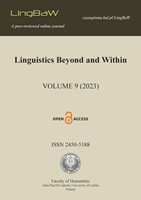When spatial agency bias and the advantage of the first mention are in contradiction: Evidence from Czech, German, and Spanish
When spatial agency bias and the advantage of the first mention are in contradiction: Evidence from Czech, German, and Spanish
Author(s): Anna Marklová, Renate Delucchi DanhierSubject(s): Psycholinguistics, Sociolinguistics, Cognitive linguistics, Descriptive linguistics, Stylistics
Published by: Wydawnictwo KUL
Keywords: mental representation; reading-writing direction; spatial agency bias; advantage of first mention; crosslinguistic comparison;
Summary/Abstract: Evidence from Art (History), perceptual psychology, and (psycho-)linguistics support the claim that in Western culture (or rather within left-to-right writing languages), people depict or visualize more important or salient figures to the left. However, linguistics studies investigating this topic almost exclusively use active sentences with standard Subject-Verb-Object (SVO) syntax as stimuli, where the subject takes the role of an agent. However natural language exhibits much more syntactical variation. To determine if this pattern is also present when the less common syntax is used, we asked native German, Spanish, and Czech speakers (N=300) to draw situations representing ten sentences varying in syntactic structure. These drawings, simplified versions of the mental representation of the situation, provide a glimpse into the conceptualization of the scenes. The spatial placement of the agent figures in the sentences was coded. Results show that although the asymmetrical effect is strong in prototypical SVO sentences, where the subject has the function of an agent and the object a function of a patient, the effect is weaker or disappears in passive sentences, where the subject at the first position is a patient and object on the second position is an agent, as well as in topicalized (OVS) sentences. Furthermore, we found crosslinguistic differences, which suggests that the character of the bias is language-specific. We postulate that placing the agent to the left is only one of the factors influencing spatial placement. The other factor playing an important role is the naming order.
Journal: Linguistics Beyond and Within (LingBaW)
- Issue Year: 9/2023
- Issue No: 9
- Page Range: 76-94
- Page Count: 19
- Language: English

